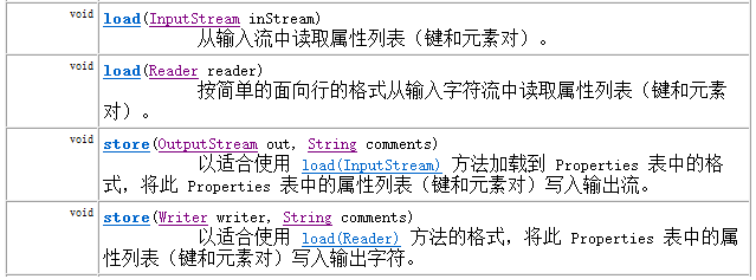一、Properties类
Properties 类表示了一个持久的属性集。Properties 可保存在流中或从流中加载。属性列表中每个键及其对应值都是一个字符串。
特点:
1、Hashtable的子类,map集合中的方法都可以用。
2、该集合没有泛型。键值都是字符串。
3、它是一个可以持久化的属性集。键值可以存储到集合中,也可以存储到持久化的设备(硬盘、U盘、光盘)上。键值的来源也可以是持久化的设备。
4、有和流技术相结合的方法。

load(InputStream) 把指定流所对应的文件中的数据,读取出来,保存到Propertie集合中
load(Reader)
store(OutputStream,commonts)把集合中的数据,保存到指定的流所对应的文件中,参数commonts代表对描述信息
stroe(Writer,comments);
/* * * Properties集合,它是唯一一个能与IO流交互的集合 * * 需求:向Properties集合中添加元素,并遍历 * * 方法: * public Object setProperty(String key, String value)调用 Hashtable 的方法 put。 * public Set<String> stringPropertyNames()返回此属性列表中的键集, * public String getProperty(String key)用指定的键在此属性列表中搜索属性 */ public class PropertiesDemo01 { public static void main(String[] args) { //创建集合对象 Properties prop = new Properties(); //添加元素到集合 //prop.put(key, value); prop.setProperty("周迅", "张学友"); prop.setProperty("李小璐", "贾乃亮"); prop.setProperty("杨幂", "刘恺威"); //System.out.println(prop);//测试的使用 //遍历集合 Set<String> keys = prop.stringPropertyNames(); for (String key : keys) { //通过键 找值 //prop.get(key) String value = prop.getProperty(key); System.out.println(key+"==" +value); } } }
需求:使用Properties集合,完成把集合内容存储到IO流所对应文件中的操作
分析:
1,创建Properties集合
2,添加元素到集合
3,创建流
4,把集合中的数据存储到流所对应的文件中
stroe(Writer,comments)
store(OutputStream,commonts)
把集合中的数据,保存到指定的流所对应的文件中,参数commonts代表对描述信息
5,关闭流
public class PropertiesDemo02 { public static void main(String[] args) throws IOException { //1,创建Properties集合 Properties prop = new Properties(); //2,添加元素到集合 prop.setProperty("周迅", "张学友"); prop.setProperty("李小璐", "贾乃亮"); prop.setProperty("杨幂", "刘恺威"); //3,创建流 FileWriter out = new FileWriter("prop.properties"); //4,把集合中的数据存储到流所对应的文件中 prop.store(out, "save data"); //5,关闭流 out.close(); } }
读取文件中的数据,并保存到集合
public class PropertiesDemo03 { public static void main(String[] args) throws IOException { //1,创建集合 Properties prop = new Properties(); //2,创建流对象 FileInputStream in = new FileInputStream("prop.properties"); //FileReader in = new FileReader("prop.properties"); //3,把流所对应文件中的数据 读取到集合中 prop.load(in); //4,关闭流 in.close(); //5,显示集合中的数据 System.out.println(prop); } }
注意:使用字符流FileReader就可以完成文件中的中文读取操作了
二、序列化流与反序列化流
1、对象序列化流ObjectOutputStream
ObjectOutputStream 将 Java 对象的基本数据类型和图形写入 OutputStream。可以使用 ObjectInputStream 读取(重构)对象。通过在流中使用文件可以实现对象的持久存储。
注意:只能将支持 java.io.Serializable 接口的对象写入流中
用于从流中读取对象的
操作流 ObjectInputStream 称为 反序列化流
用于向流中写入对象的操作流 ObjectOutputStream 称为 序列化流
l 特点:用于操作对象。可以将对象写入到文件中,也可以从文件中读取对象。


public class ObjectStreamDemo { public static void main(String[] args) throws IOException, ClassNotFoundException { /* * 将一个对象存储到持久化(硬盘)的设备上。 */ writeObj();//对象的序列化。 } public static void writeObj() throws IOException { //1,明确存储对象的文件。 FileOutputStream fos = new FileOutputStream("tempfile\obj.object"); //2,给操作文件对象加入写入对象功能。 ObjectOutputStream oos = new ObjectOutputStream(fos); //3,调用了写入对象的方法。 oos.writeObject(new Person("wangcai",20)); //关闭资源。 oos.close(); } }
Person类
public class Person implements Serializable { private String name; private int age; public Person() { super(); } public Person(String name, int age) { super(); this.name = name; this.age = age; } public String getName() { return name; } public void setName(String name) { this.name = name; } public int getAge() { return age; } public void setAge(int age) { this.age = age; } @Override public String toString() { return "Person [name=" + name + ", age=" + age + "]"; } }
2、对象反序列化流ObjectInputStream


public class ObjectStreamDemo { public static void main(String[] args) throws IOException, ClassNotFoundException { readObj();//对象的反序列化。 } public static void readObj() throws IOException, ClassNotFoundException { //1,定义流对象关联存储了对象文件。 FileInputStream fis = new FileInputStream("tempfile\obj.object"); //2,建立用于读取对象的功能对象。 ObjectInputStream ois = new ObjectInputStream(fis); Person obj = (Person)ois.readObject(); System.out.println(obj.toString()); } }
3、序列化接口
当一个对象要能被序列化,这个对象所属的类必须实现Serializable接口。否则会发生异常NotSerializableException异常。
public class Person implements Serializable { //给类显示声明一个序列版本号。 private static final long serialVersionUID = 1L; private String name; private int age; public Person() { super(); } public Person(String name, int age) { super(); this.name = name; this.age = age; } public String getName() { return name; } public void setName(String name) { this.name = name; } public int getAge() { return age; } public void setAge(int age) { this.age = age; } @Override public String toString() { return "Person [name=" + name + ", age=" + age + "]"; } }
4、瞬态关键字transient
当一个类的对象需要被序列化时,某些属性不需要被序列化,这时不需要序列化的属性可以使用关键字transient修饰。
只要被transient修饰了,序列化时这个属性就不会序列化了。
同时静态修饰也不会被序列化,因为序列化是把对象数据进行持久化存储,而静态的属于类加载时的数据,不会被序列化。
public class Person implements Serializable { /* * 给类显示声明一个序列版本号。 */ private static final long serialVersionUID = 1L; private static String name; private transient/*瞬态*/ int age; public Person() { super(); } public Person(String name, int age) { super(); this.name = name; this.age = age; } public String getName() { return name; } public void setName(String name) { this.name = name; } public int getAge() { return age; } public void setAge(int age) { this.age = age; } @Override public String toString() { return "Person [name=" + name + ", age=" + age + "]"; } }